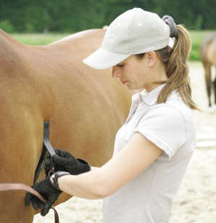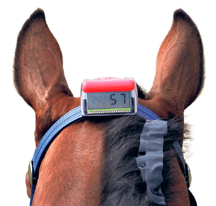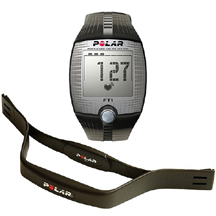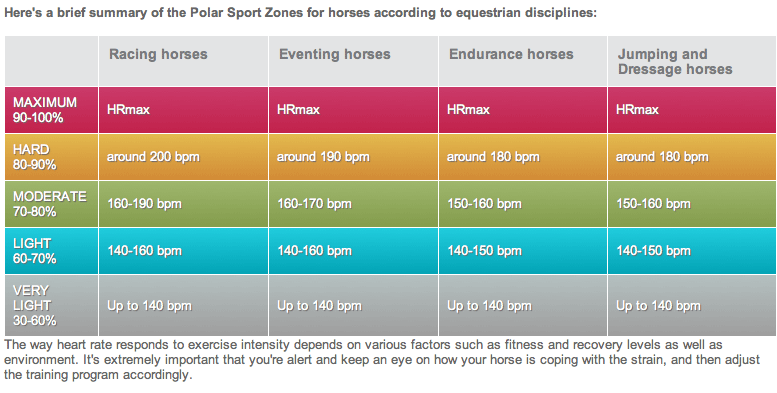Using the Heart Rate Meter
Using the Heart Rate Meter
By Gayle L. Ecker - ERC Research Staff
There has been a growing interest in the use of heart rate (HR) meters for training competitive horses. With the convenience of the latest models, it is no wonder that horse owners are realizing the additional benefits to their training programs, which can be afforded by a good heart rate meter. Many people acknowledge that the meter would be helpful, but are unsure about its practical uses or just how to go about using one. There is no one recipe that fits all horses but hopefully the following information and suggestions will allow you to see its benefits and perhaps encourage you to add a HR meter to your "trainer's toolbox."
Some of the uses for a HR meter will be discussed below in order to help you understand its applications in the field.
1.Determine the metabolic demands of your sport by monitoring the HR during a "mock" event. This will help to find out the HR pattern the horse will be experiencing, and will help to decide in a general way, the relative contributions of aerobic or anaerobic energy production. Training exercises can then be tailored to suit the demand.
2.Monitor the progress of your horse and its response to the training program by day-to-day observations.
3.Collect objective evaluations of the training state of your horse by repeated fitness tests.
Getting Started
Once you have a meter you should be using it regularly to become familiar with the normal response of the horse. This will make you more aware of possible warning signs that there might be a problem with the horse or with the HR meter. Isolated observations of a fitness test administered only once is of limited use since distractions and errors can influence the results. The trainer should never concentrate solely on the HR readings of course, but must be alert for the "look" or "feel" of the horse, as well as paying close attention to the legs. When used regularly, a heart rate meter may actually warn you of a lameness, a viral infection, or other problems. When you notice a HR higher than normal for a set workload, a longer recovery period, or if the heart rate is erratic (not only during the work but also during the warm-up or cool-down), check out the horse before doing more work. You may on occasion feel that the horse is sluggish and not trying hard, but the HR is higher than normal. Take this as a warning sign that a problem may be developing and end the exercise. If you are getting readings that seem to high, there could be a problem with the meter and this should be checked out immediately.
Ready For Training
It is difficult to give an actual training HR recommendation as this depends on so many factors; initial condition of the horse, ability of the rider, aims of the training program, to name just a few. It would be advisable to start off with a range of 120 - 140 as the target range and as the horse demonstrates that this is within his tolerance range, as judged by his energy level, his recovery rate and attitude, then begin to increase the rate every two to three weeks, to 130 - 150, 140 - 160, and up from there. If in doubt, always choose the less intense level. Secondly, always increase the duration before the intensity. When the horse is handling the new workout well, then you can increase the intensity (or target HR) but always decrease duration at the same time. If you notice the speed is decreasing while the heart rate is drifting up, then the horse has not adapted to that level and should not be moved up.
For those with a good understanding of interval-type training, the following criteria for HR during interval training have been suggested (Dr. Warwick Bayly, published in Rose, RJ Exercise Physiology).
•Relief period criteria - HR should fall to 110 or less within the 5 min. post-interval. If not, go into the cooling out phase (i.e. quit).
•Interval criteria - If the interval time (time taken to complete the scheduled distance) is grater than 1.5 seconds more than the scheduled time, then quit and go into the cooling out phase.
The actual values are somewhat arbitrary and should be considered as guidelines only, It is never advisable to depend on "recipes" for training that do not allow for individual variations and changing environmental conditions. Intense activity should never be attempted until you have built a solid training foundation based on aerobic work. Above all, use your judgment!
To get a better idea of the intensity demanded by your chosen short, use the HR meter on a well-trained animal as the horse goes through the event to see the level of intensity that will be part of your training target. (Remembering of course, that structural adaptations are as important and may take longer to develop.) For example, if you take a well-trained endurance horse out on the trail and find that he runs at a competitive speed over the distance, while averaging a HR of 140 to 160 bpm, then the average speed will be one of your long-term goals. You will want to build an aerobic base in order for the horse to handle higher speeds while averaging a HR of 140-160 bpm. Remember the relationship between workload and HR; that is, the HR increases linearly with the speed. As the horse increases its fitness level, the speed at a heart rate of 160 bpm (called a V160 under controlled testing) will increase with aerobic conditioning. Following this training the horse will be more competitive and will recover faster at the vet checks. The use of HR meters is growing in the sport of endurance riding since the meters provide essential information during the ride. such as the HR across terrain so that the horse can be rated more accurately, and for following the recovery rate in order to save time at the vet checks.
Although the meter can give valuable information for any sport, the heart rate meter is not just for riders or drivers. It can also be used while longeing the horse if it has a training zone alarm function of large digital display. Readings obtained can also be enlightening to give some idea of the excitability level in horses in new environments.
Make Sure You Have an Accurate Signal
It is crucial to know the confidence level of the meter. The signal could lie plus or minus 8 beats per minute or more from the true heart rate. This could become very serious at the higher heart rates. The variation you are seeing following one fitness test may be only due to the variation in signal and may not represent a true training response. This variability can be compensated by frequent testing. Even the best HR meters will have some inherent variability. It is because of the variability of the signal that it is extremely dangerous to attempt to push a horse to near-maximum heart rates during training.
Summary
One can't rely on the science alone of course. The trainer must always develop the art of horsemanship and knowledge of the individual horse and the physiological as well as the mental response to training. If you have been giving serious thought to getting a heart rate meter now is the time to invest in one. That way you can follow the training progress of your horse throughout the upcoming competitive season.
Before You Pay
When choosing a heart rate meter, consider the following:
1. On what type of horse and for what purpose will it be used? Some models are designed specifically for jog carts, others for a saddle and still others provide flexibility for both methods. Certain models have been designed for a certain type or size of horse and may not be flexible enough to accommodate a horse that is small, large-barrelled, or tall.
2. See if you can get a trial model, a demonstration, or at least, the names of current users of that particular model so that you can see if the meter is suitable for your needs.
3. Inquire about the level of customer support offered by the company. Who do you call if problems arise, what is the guarantee, what is the down-time if repairs are needed, could a demonstrator model be loaned to you while repairs are being effected, how durable are they and what are the usual repair problems encountered by users?
4. Has the meter been specifically designed for horses? Some models may actually be modified human models and will not have the accuracy that you need for your horse.
5. Some units are hardwired to the meter, which is worn by the rider, others may use telemetry to send the signal to a wrist watch worn by the rider. Be aware that most telemetry units have a short range and the signal can be blocked out by interference. If you opt for the hard wire units then make sure the display is easy to read, that the location of the meter will be comfortable for you and that there is a quick release on the wire in case of an accident.
6. Do you require computer compatibility? Some units are able to store the data and download the results into a computer for analysis or comparisons. Make sure the system will be compatible with existing computer systems.
7. Check out the type and quality of electrodes, where and how they are attached to the horse. They should be convenient to place and remain in place without shifting during the exercise, otherwise you are in the frustrating situation of having to stop the horse and reapply the electrodes. Electrodes that are pre-mounted on a saddle or girth may not be suitable for horses of varying size and shapes. Good electrodes should not irritate the skin when properly placed, although you may notice some bruising of the skin after extended use under the saddle.
8. Various other options may be available such as headphones for verbal communication between trainer and rider, memory functions, or stop watches. Check the options and make sure they are worth the expense. Memory functions may be useful to play back the readings to see the peak HR achieved during the training session. Those meters that give an audible "training zone" signal are useful for general-purpose, as it is easier to train in a target range rather than at a specific HR.
9. The accuracy of the HR meter is critical if you are doing high intensity work or long duration work.
If you are going to get a heart rate meter, it is worth getting an accurate one. Consider it a long-term investment that adds valuable information for your training program. For more details on the accuracy of various models, there is reading material to help you, or check with your veterinarian or other knowledgeable sources.
The contents are copyrighted but may be copied,
on condition that the Equine Research Centre be
acknowledged for the use of its information.

The Equine Research Centre
University of Guelph
Guelph, ON N1G 2W1




- Log in to post comments
